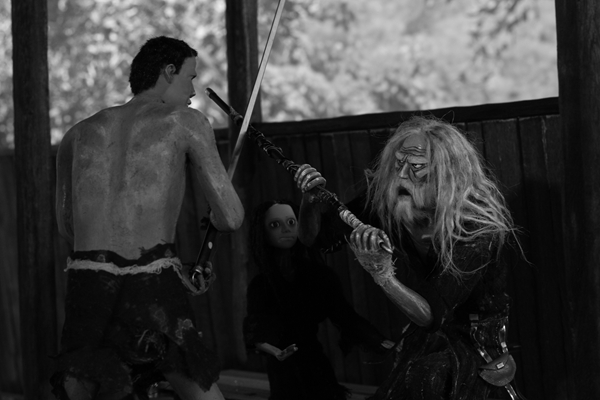
Its almost stuttering style resembles the earliest films, from the very dawn of the industry. But it requires determination, dexterity and imagination. Each piece must be carefully placed for a frame, then moved again. It is the old-school film animation technique of stop-motion and it's winning over fans who appreciate its artistry. This past summer, the 22-minute animated film Bridge led to a surge of interest in the format.
The black-and-white film has notched up over 1.2 million views on video-sharing platforms Bilibili and AcFun (meaning Anime Comic Fun), since it premiered in June.
It has obtained a rating of 8.8 points out of 10 on China's major review platform Douban.
One online viewer comments: "Although it's a stop-motion animation, the characters' movements flow well. I also noticed such details as the protagonist's heaving chest and his thinning hair blowing in the wind. The plot carried me from start to finish."
Last year, it was selected by the Annecy International Animation Film Festival as one of the 40 animated short film entries for its official competition, out of more than 3,000 submissions across all categories from 86 countries, with the bulk of entries coming from France, the United Kingdom and the United States.
The captivating story is set during the turbulence of the late Tang Dynasty (618-907), when war was raging, food was scarce and cannibalism occurred. It opens with a starving girl, dressed in rags, stealing a piece of pancake from an emaciated old man. But she leaves her beloved rattle behind. The following story tells how the old man, once being a xiake (swordsman), sacrifices his own life to save the girl from the wicked intentions of a fiendish soldier and a cruel robber.
In his last minute of life, he attempts to return the rattle to the girl he saved. However, she ignores him and snatches his last piece of pancake. The story shows that the old man has lived and died by a code of honor.
Liu Di, the film's scriptwriter and director, has been working with stop-motion animation since he graduated as a digital media major from Dalian Polytechnic University in 2012.
With the advance of 2D and 3D animation technologies, the traditional cinematographic technique of stop-motion has become marginalized in the market and deemed unprofitable. The small company Liu worked for nearly went bankrupt in 2016; some of his colleagues chose to switch to other occupations.
"We used to make animated videos for children to watch, but seldom focused on our self-expression. I thought it's time for us to film something we really wanted to, as it was our last effort," says Liu, 31, recalling that low ebb in his life.
The script of Bridge was written by Liu in his spare time to practice writing skills. He decided to try and persuade his colleagues to film the story. "By filming Bridge, we want to prove what we've learned from our years of experience in making stop-motion films," says Liu.
There were just six core members in the production team. With a tight budget and limited space, they started to make it happen.
This kind of animation takes a fairly long time to execute, as, generally, 12 frames equate to around one second of video. To ensure fluid fighting scenes, Liu created some parts of the film at 24 frames per second, which vastly increased the team's workload. Sometimes, they had to work around the clock. They shot a total of about 14,500 photos for the animation.
To prepare, the team made a 5-meter-wide wooden bridge that could be partly dismantled for the convenience of shooting interior scenes. And a 1-meter-wide bridge model was also built to help complete exterior shots.
Metal frameworks, silicone molds, industrial resin and other materials were used to make the flexible puppets. Handmade clothes, carefully-crafted swords, miniature buildings and real human hair were applied to add the sense of reality.
"The story of Bridge is ideal to be filmed through stop-motion, as the form helps to create and strengthen the bleak atmosphere, ancient flavor and its sense of reality," says Liu. "The audience could clearly see the wrinkles on characters' faces, the texture of their clothes and the roughness of the tree bark, all of which help to set the mood."
Besides, Liu continually watched and retouched the puppets throughout the process. This kind of "company", in his view, allowed him to deeply understand the characters' feelings and emotions. "When I stared at the dilapidated bridge, blood stains on the ground and the protagonist's wrinkled face, I felt that I had a stronger connection with the character and knew how we should arrange his next movement," Liu explains.
The team members' increasing empathy with the characters on the scene inspired them to alter some plotlines.
Liu also points out that different from 2D and 3D animation, the stop-motion animation doesn't require animators to monotonously sit before the computer screen and operate software for all day long. To make a stop-motion video, one also should learn how to sculpt a face, build an armature, or design a way to combine various materials together, which brings so much fun to creators.
The popularity of Bridge has not only brought Liu more confidence, but also attracted more investors and animation industry practitioners to cooperate with his team.
He plans to create stop-motion films based on realistic topics or sci-fi subjects in the future.
"The medium has far more potential for us to tap into," Liu says. "If we practitioners are willing to make the effort to explore more possibilities of stop-motion, it will be assured of a place in the market."